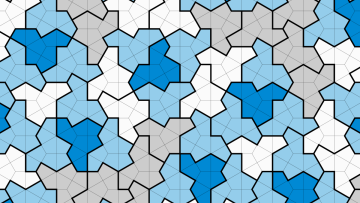In many modern applications, a key bottleneck is the solution of a matrix problem of the form Ax=b where A is a large matrix. In numerical weather prediction, such systems arise as a sub-problem within data assimilation algorithms. In this setting, finding the most likely initial condition with which to initialise a forecast is equivalent to finding the (approximate) solution x.
Structured Networks and Coarse‐Grained Descriptions
Schaub, M
Delvenne, J
Lambiotte, R
Barahona, M
Advances in Network Clustering and Blockmodeling
333-361
(23 Nov 2019)
Different Approaches to Community Detection
Rosvall, M
Delvenne, J
Schaub, M
Lambiotte, R
Advances in Network Clustering and Blockmodeling
105-119
(23 Nov 2019)
Higher Analytic Torsion, Polylogarithms and Norm Compatible Elements on Abelian Schemes
Kings, G
Rössler, D
Geometry, Analysis and Probability
volume 310
99-126
(27 Apr 2017)
Chains of Large Gaps Between Primes
Ford, K
Maynard, J
Tao, T
Irregularities in the Distribution of Prime Numbers
1-21
(05 Jul 2018)
Sums of Two Squares in Short Intervals
Maynard, J
Analytic Number Theory
253-273
(2015)
Test Models for Statistical Inference: Two-Dimensional Reaction Systems Displaying Limit Cycle Bifurcations and Bistability
Plesa, T
Vejchodský, T
Erban, R
Stochastic Processes, Multiscale Modeling, and Numerical Methods for Computational Cellular Biology
3-27
(05 Oct 2017)
Tue, 10 Oct 2023
13:00
13:00
L1
Generalized Symmetries in Argyres-Douglas Theories
Alessandro Mininno
(DESY)
Abstract
In this talk, I will discuss the dynamical consequences of having 1-form, 2-group and non-invertible symmetries in Argyres-Douglas (AD) theories.
I will first review how to construct (G,G') and D_p(G) theories from geometric engineering. Then, I will briefly introduce how 1-form symmetries are found in these AD theories, focusing on their dynamical consequences in the study of the Higgs branch for such theories. Analogously, I will show how certain D_p(G) theories enjoy a 2-group structure due to a non-trivial extension between a discrete 1-form symmetry and a continuous 0-form symmetry, emphasizing the dynamical consequences that a 2-group structure entails, and the family of AD theories that have it. This analysis allowed us to "bootstrap" families of D_p(G) theories sharing the same properties. Finally, I discuss the presence of non-invertible symmetries in AD theories obtained by gauging the flavor symmetry of multiple D_p(SU(N)) theories.
I will first review how to construct (G,G') and D_p(G) theories from geometric engineering. Then, I will briefly introduce how 1-form symmetries are found in these AD theories, focusing on their dynamical consequences in the study of the Higgs branch for such theories. Analogously, I will show how certain D_p(G) theories enjoy a 2-group structure due to a non-trivial extension between a discrete 1-form symmetry and a continuous 0-form symmetry, emphasizing the dynamical consequences that a 2-group structure entails, and the family of AD theories that have it. This analysis allowed us to "bootstrap" families of D_p(G) theories sharing the same properties. Finally, I discuss the presence of non-invertible symmetries in AD theories obtained by gauging the flavor symmetry of multiple D_p(SU(N)) theories.
My results are based on arXiv:2203.16550 [hep-th], arXiv:2208.11130 [hep-th] and arXiv:2303.16216 [hep-th].
We will be celebrating the discovery of 'The Hat', a tile which tiles only aperiodically, on the 20th and 21st July here in the Mathematical Institute, Oxford. Come and join us!
The theory of tilings in the plane touches on diverse areas of mathematics, physics and beyond. Aperiodic sets of tiles, such as the famous Penrose tiling that you see as you walk into the Mathematical Institute, admit tilings of the plane without any translational symmetry.



